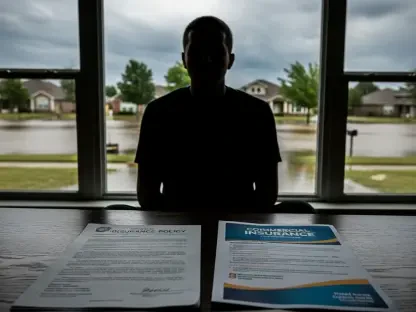The marine hull insurance sector stands at a critical juncture, navigating a landscape where modest premium growth collides with intensifying risks and a softening market environment, as highlighted by insights from a recent global conference hosted by the International Union of Marine Insurance (IUMI). The industry is under strain, as economic opportunities are overshadowed by operational challenges. With premiums rising by 3.5% last year to $9.67 billion, the market appears stable on the surface, yet deeper issues such as aging fleets, geopolitical tensions, and emerging technological hazards threaten long-term sustainability. Europe holds a dominant 53% share of this market, followed by Asia-Pacific at 35%, while competitive pressures drive a focus on expansion over technical rigor. This dynamic sets the stage for a deeper exploration of the factors reshaping marine hull insurance, from escalating claims to the complexities of the energy transition, all while the industry seeks adaptive solutions.
Economic Growth Amid Market Softness
The marine hull insurance market’s recent premium growth signals a degree of economic optimism, yet it masks underlying vulnerabilities that could undermine stability. Last year’s increase to $9.67 billion reflects a positive sentiment tied to the global fleet’s value, which rose by 4% to $1.54 trillion. However, this growth comes in a softening market, where intense competition and expanded underwriting capacity often prioritize volume over disciplined risk assessment. Such conditions heighten exposure to significant losses, especially in major premium hubs where a single incident can have outsized financial impacts. The balance between capitalizing on growth and maintaining technical standards remains precarious, as insurers grapple with the temptation to chase market share at the expense of long-term resilience. This tension underscores a critical need for strategic caution in an environment where economic indicators suggest strength, but structural weaknesses loom large beneath the surface.
Beyond the numbers, the softening market reveals a deeper challenge in managing risk amid competitive pressures that erode pricing discipline. With more players entering the space and capacity outpacing demand, insurers face a landscape where margins are squeezed, and the ability to absorb major claims is tested. This situation is particularly acute in regions with high premium concentration, where a single catastrophic event could ripple through the market. The drive for growth often overshadows the importance of rigorous underwriting practices, leaving the sector vulnerable to sudden shifts in loss patterns. As the industry navigates this delicate balance, the focus must shift toward sustainable strategies that prioritize quality over quantity, ensuring that economic gains do not come at the cost of heightened exposure. Addressing this softness will require a concerted effort to realign priorities, emphasizing technical expertise over short-term market gains.
Escalating Risks from Aging Fleets and Claims
One of the most pressing concerns for marine hull insurers is the aging profile of the global fleet, which continues to drive claims and complicate risk management. With an average vessel age of 22.6 years, over 35% of ships are more than 25 years old, and 61% exceed 15 years. Older vessels are disproportionately involved in incidents—over half of last year’s events involved ships over 20 years old—often resulting in costly constructive total losses or unrepaired damage claims due to uneconomical repair costs. A modest order book for new vessels, representing just 16% of the existing fleet, combined with low scrapping rates, means this aging issue will persist. Insurers must contend with heightened exposure as these vessels remain in service, prone to breakdowns and accidents that strain loss ratios and challenge underwriting models. This persistent risk factor demands innovative approaches to mitigate the financial impact of an outdated fleet.
Compounding the issue of aging ships are the rising severity and complexity of claims, which remain above pre-COVID levels and test the industry’s capacity to respond. Machinery failures stand out as the primary cause of losses, while fires and explosions, though less frequent, incur significant costs when they occur. Additionally, incidents such as collisions, groundings, and heavy-weather damage have seen upticks, partly due to rerouting around conflict zones like the Red Sea, which increases voyage times and exposure to engine stress and salvage expenses. Repair costs have surged, further pressuring loss ratios even as the total number of major incidents has not dramatically spiked. These evolving claim patterns highlight the need for insurers to adapt their risk assessment frameworks, ensuring they account for both the frequency and escalating financial impact of modern maritime incidents. The industry faces a clear imperative to refine its approach to these growing challenges.
Geopolitical and Energy Transition Challenges
Geopolitical instability adds another layer of complexity to the marine hull insurance market, directly influencing operational risks and underwriting conditions. Tensions in areas such as the Red Sea and the ongoing Ukraine-Russia conflict have led to longer voyage routes, higher war premiums, and increased costs related to engine failures and weather-related damage. The rise of a shadow fleet, comprising roughly 17% of global vessels often tied to sanctions evasion in the tanker sector, introduces compliance burdens and complicates risk accumulation. Beyond financial impacts, the human cost is evident with rising crew detentions and abandonments in conflict zones. These factors create a volatile environment where insurers must navigate not only economic pressures but also the broader implications of global unrest, demanding a nuanced approach to policy design and risk mitigation in an increasingly uncertain world.
Simultaneously, the energy transition introduces novel risks as the industry shifts toward sustainability, reshaping the hazard landscape for insurers. Last year, 25% of newbuilding orders were for vessels using alternative fuels like methanol and ammonia, with projections showing an increase to 31% for orders placed this year. Similarly, deliveries of alternative-fuel-capable ships are rising, with 12.8% last year and an expected 15.4% of upcoming deliveries. While this aligns with environmental goals, it brings uncharted risks due to complex machinery and limited repair data, heightening the potential for costly incidents. The slow replacement rate of older vessels with these newer designs means the fleet’s average age remains high, compounding exposure. Insurers must develop expertise in these emerging technologies to manage the associated risks effectively, balancing the push for green innovation with the practical challenges of insuring cutting-edge systems.
Building Resilience Through Education and Adaptation
In response to these multifaceted challenges, efforts are underway to strengthen the marine hull insurance sector through targeted skill development and strategic adaptation. A notable initiative is a recently launched Hull Masterclass program by industry leaders, designed to equip practitioners with essential technical knowledge and underwriting expertise. Covering critical areas such as policy wording and casualty management, this educational effort aims to foster greater resilience by enhancing the industry’s ability to handle complex risks. By investing in professional development, the sector seeks to address the gap between current market pressures and the need for disciplined practices, ensuring that growth does not compromise stability. Such programs represent a proactive step toward preparing insurers for the evolving demands of a high-risk environment.
Reflecting on the path forward, the industry recognizes that past efforts to balance economic opportunities with rising risks have often fallen short due to competitive pressures and insufficient focus on technical rigor. Yet, the commitment to initiatives like specialized training marks a pivotal shift toward sustainable solutions. The emphasis on education and adaptation offers a blueprint for tackling the intertwined challenges of aging fleets, geopolitical disruptions, and technological transitions. Moving ahead, stakeholders are encouraged to prioritize long-term strategies over short-term gains, integrating advanced risk assessment tools and fostering collaboration across regions. By building on the lessons of previous years, the marine hull insurance market can chart a course toward greater stability, ensuring that it not only weathers current storms but also emerges stronger to face future uncertainties.









